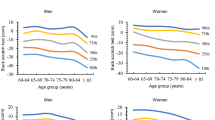Abstract
Physical fitness for young people is viewed as a multidimensional construct, in that it consists of specific components such as strength, mobility, balance, flexibility, and stamina. This study examined whether this structure underlying physical fitness is also relevant to older adults. A 10- item performance test, which was assumed to assess six components of physical fitness, was administered to 69 healthy volunteers ranging in age from 61 to 83 years. A covariance structure model was applied to the test data: the second- order factor was Physical Fitness, and the first- order factors were Strength, Walking, Balance, Flexibility, Stamina, and Manual Speed which were assumed to be measured based on the ten observed variables. Goodness- of- fit index (GFI) of the model was acceptable (GFI=0.93). While four factors relating to basic motor performances (Strength, Walking, Balance, and Manual Speed) had loadings more than 0.62 to Physical Fitness, Flexibility and Stamina had less than 0.35. It was suggested for elderly people that strength, mobility, balance, and speed components of physical fitness were highly correlated and explainable by a single factor, while flexibility and cardiorespiratory endurance were to be measured by use of specific measures.
Similar content being viewed by others
References
Falls H.B.: Modem concepts of physical fitness. JOPER 51: 25–27, 1980.
Canadian standardized test of fitness. Fitness Canada, Ottawa. 1987.
Briggs R.C., Gossman M.R., Drews J.E., Shaddeau S.A.: Balance performance among noninstitutionalized elderly women. Phys. Therapy 70: 410–415, 1989.
Tinetti M.E., Ginter S.F.: Identifying mobility dysfunctions in elderly patients. Standard neuromuscular examination or direct assessment? JAMA 259: 1190–1193, 1988.
Carter J.S., Williams H.G., Macera C.A.: Relationships between physical activity habits and functional neuromuscular capacities in healthy older adults. J. Appl. Gerontol. 12: 283–293, 1993.
Greene L.S., Williams H.G., Macera C.A.: Identifying dimensions of physical (motor) functional capacity in healthy older adults. J. Aging Health 5:163–178, 1993.
Era P.: Sensory, psychomotor and motor functions in men of different ages. Scand. J. Social Med. 39: 9–77, 1990.
Fleishman E.A., Quaintance M.K.: Taxonomies of human performance. Academic Press, New York, 1984.
Fleishman E.A.: The structure and measurement of physical fitness. Prentice-Hall, Englewood Cliffs, NJ, 1964.
Parker J.F., Fleishman E.A.: Ability factors and component performance measures as predictors of complex tracking behavior. Psychol. Monograph. 74 (Whole No. 503), 1960.
Nagasaki H., Itoh H., Furuna T.: The structure underlying physical performance measures for older adults in the community. Aging Clin. Exp. Res. (in press), 1995.
Kinugasa T., Nagasaki H., Itoh H., Hashizume K., Furuna T., Maruyama H.: Aging effect on motor ability for male subjects aged from 18 to 83 years (in Japanese). Jpn. J. Phys. Fitness Sports Med. 43: 343–351, 1995.
Nagasaki H., Itoh H., Hashizume K., Furuna T., Maruyama H., Kinugasa T.: Walking patterns and finger festination in the elderly. Exp. Aging Res. (in press), 1995.
Furuna T., Nagasaki H., Itoh H., Fujisawa A., Niimi M., Maruyama H., Kinugasa T.: Effect of aging on the aerobic capacity measured by a step-test (in Japanese). Jpn. J. Geriatr. 31:40–47, 1994.
Nagasaki H., Itoh H., Maruyama H., Hashizume K.: Characteristic difficulty in rhythmic movement with aging and its relation to Parkinson’s disease. Exp. Aging Res. 14: 171–176, 1988.
Wagenaar R.C., Beek W.J.: Hemiplegic gait: A kinematic analysis using walking speed as a basis. J Biomech. 25: 1007–1015, 1992.
Avlund K., Schroll M., Davidsen M., Lovborg B., Rantanen T.: Maximal isometric strength and functional ability in daily activities among 75-year-old men and women. Scand. J. Med. Sci. Sports 4: 32–40, 1994.
Long J.S.: Confirmatory factor analysis: A preface to LISREL. Sage Publications, Beverly Hills, 1983.
Blair S.N.: Physical activity, physical fitness, and health. Res. Quart. Exer. Sport 64: 365–376, 1993.
Author information
Authors and Affiliations
Rights and permissions
About this article
Cite this article
Nagasaki, H., Itoh, H. & Furuna, T. A physical fitness model of older adults. Aging Clin Exp Res 7, 392–397 (1995). https://doi.org/10.1007/BF03324351
Received:
Accepted:
Published:
Issue Date:
DOI: https://doi.org/10.1007/BF03324351




